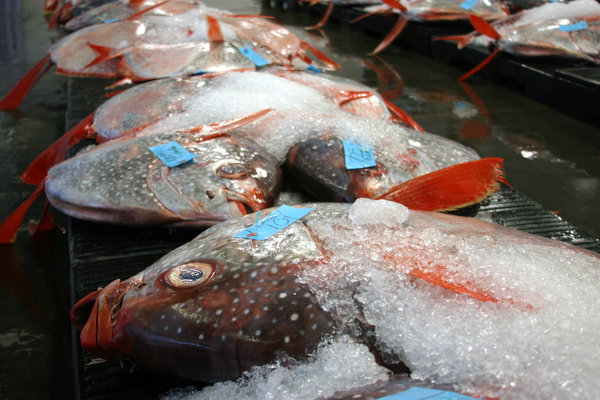VIA – LA TIMES
Opah, also called moonfish, were one of nine fish species analyzed in a new study that looked at how mercury gets into open-ocean fish and why the levels vary with depth. (C. Anela Choy / University of Hawaii / August 27, 2013)
Mercury found in high levels in deep Pacific Ocean fish such as swordfish has a chemical fingerprint, and it implicates coal-burning power plants in Asia, according to a new study.
A research team from the universities of Hawaii and Michigan looked at mercury in the flesh of nine species common to the massive North Pacific Subtropical Gyre, the largest ecosystem on the planet, at 7 million square miles.
Four years ago, the team found that mercury levels in such fish as tuna increased with the depth of the fish’s habitat. This time, they set out to find out why, and what forces were at play. On the way, however, they found evidence implicating coal. The results were published online in Nature Geoscience.
Sunlight breaks down the kind of mercury that’s dangerous on the sushi platter: monomethylmercury, according to the study. That makes shallower species, such as yellowfin tuna and mahi mahi, a safer dining bet, Popp suggested.
“If you are concerned about high levels of mercury in fish, consume those that are feeding shallowest in the water,” said Brian Popp, a University of Hawaii geochemist who was part of the research team.
But different processes also change the ratio of isotopes of mercury — chemists call it fractionation. The sunlight-driven (photochemical) processes in shallower water result in one isotope ratio, while processes driven by living things — microbes, for instance — leave another fingerprint. Comparing those ratios and doing a bit of calculation helped the team figure out the “fingerprint” of the mercury before these processes came into play. And that mercury fingerprint looked suspiciously like the mercury that comes from the atmosphere.
“The surprising thing is that when we remove this fingerprint of organic mercury, we get a match between elemental mercury in the atmosphere and the isotopic compositions in fish,” Popp said. “People have speculated that the main source of mercury to the ocean is through atmospheric deposition, but people have also argued that it comes from sediments, hydrothermal activity, coastal sediment that’s moved from the coast to the open ocean. Our work suggests the main source is from the atmosphere.”
Prevailing winds carry atmospheric mercury from Asia, where countries such as China have greatly increased their use of coal to generate electricity.
Further bolstering the role of Asian coal burning are previous studies that have show drops in organic mercury levels in deep Atlantic fish — in areas adjacent to countries where mercury emissions have been reduced.
The mystery that remained, however, was why organic mercury concentrations increased with the depth of a fish’s feeding zone, despite its photochemical breakdown in shallower waters. The answer, according to the report, is microbes assembling elemental mercury into “organic” mercury — a clue found in the istope fingerprints.
About 80% of the organic mercury in the tissue of fish from the deep probably was produced by these bacteria clinging to sinking particles of organic matter, the study suggested.
“It tells us information that we kind of knew,” Popp said. “Now we understand why.”
For the original post go here:
 Become A Sponsor!
Become A Sponsor!If you have a product or service that is a good fit for our surf community, we have opportunities for you to sponsor this blog! Download our media kit now!

